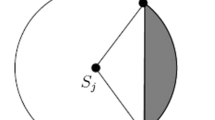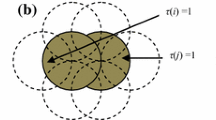Abstract
One of the major challenges in the area of wireless sensor networks is simultaneously reducing energy consumption and increasing network lifetime. Efficient routing algorithms have received considerable attention in previous studies for achieving the required efficiency, but these methods do not pay close attention to coverage, which is one of the most important Quality of Service parameters in wireless sensor networks. Suitable route selection for transferring information received from the environment to the sink plays crucial role in the network lifetime. The proposed method tries to select an efficient route for transferring the information. This paper reviews efficient routing algorithms for preserving k-coverage in a sensor network and then proposes an effective technique for preserving k-coverage and the reliability of data with logical fault tolerance. It is assumed that the network nodes are aware of their residual energy and that of their neighbors. Sensors are first categorized into two groups, coverage and communicative nodes, and some are then re-categorized as clustering and dynamic nodes. Simulation results show that the proposed method provides greater efficiency energy consumption.














Similar content being viewed by others
References
Akyildiz I, Su W, Sankarasubramaniam Y, Cayirci E (2008) A survey on sensor networks. Comput Netw 52(12):2292–2330
Pottie GJ, Kaiser WJ (2000) Wireless sensor networks. Commun ACM 43(5):51–58
Labrador MA, Wightman PM (2009) Topology control in wireless sensor networks. In Springer, Berlin ISBN: 978-1-40209589-9
Shojafar M, Pooranian Z, Shojafar M, Abraham A (2013) LLLA: New Efficient Channel Assignment Method in Wireless Mesh Networks. Springer International Publishing, Innovations in Bio-inspired Computing and Applications 237:143–152
Akyildiz IF, Melodia T, Chowdhurry KR (2007) A survey on wireless multimedia sensor networks. Comput Netw 51(4):921–960
Sayyad A, Ahmadi A, Shojafar M, Meybodi MR (2010) Improvement multiplicity of routs in directed diffusion by learning automata new approach in directed diffusion. In: International conference on computer technology and, development, pp 195–200
Sayyad A, Shojafar M, Delkhah Z, Ahamadi A (2011) Region directed diffusion in sensor network using learning automata: RDDLA. J Adv Comput Res 1(3):71–83
Sayyad A, Shojafar M, Delkhah Z, Meybodi MR (2010) Improving directed diffusion in sensor network using learning automata: ddla new approach in directed diffusion. In: 2nd International conference on computer technology and development (ICCTD 2010), pp 189–194
Ghosh A, Das SK (2008) Coverage and connectivity issues in wireless sensor networks: a survey. Pervasive Mobile Comput 4(1):303–334
Younis M, Akkaya K (2008) Strategies and techniques for node placement in wireless sensor networks: a survey. Elsevier Ad Hoc Netw 6:621–655
Stojmenovic I, Lin X (2001) Loop-free hybrid single-path/flooding routing algorithms with guaranteed delivery for wireless networks. IEEE Trans Parallel Distrib Syst 12(10):1045–9219
Yang S, Dai F, Cardei M, Wu J (2006) On connected multiple point coverage in wireless Sensor networks. J Wirel Inf Netw
Huang Y, Tseng Y (2003) The coverage problem in a wireless sensor networks. In: Proceedings of the 2th ACM international conference on information proceedings in sensor networks and applications, pp 115–121
Benyuan L, Dousse O, Nain P, Towsley D (2013) Dynamic coverage of mobile sensor networks. IEEE Trans Parallel Distrib Syst 24(2):301–311
Li S, Kao HC (2010) Distributed K-coverage self-location estimation scheme based on Voronoi diagram. Commun IET 4(2):167–177
So AM, Ye Y (2005) On solving coverage problems in a wireless sensor network using Voronoi diagrams. In: Proceedings of workshop on internet and network economics, vol 3828, pp 584–593
Okabe T, Boots B, Sugihara K, Chiu SN (2000) Spatial tessellations: concepts and applications of Voronoi diagrams. 2nd edn. Wiley, New York
Powers RA (1995) Batteries for low power electronics. Proc IEEE 83(4):687–693
Shen CC, Srisathapornphat C, Jaikaeo C (2001) Sensor information networking architecture and applications. IEEE Pers Commun 8(4):52–59
Howard A, Mataric M, Sukhatme G (2002) Mobile sensor network deployment using potential fields: a distributed, scalable solution to the area coverage problem. In: Distributed autonomous robotic systems, vol 5. Springer, Berlin, pp 299–308
Hefeeda M, Bagheri M (2007) Randomized K-Coverage algorithms for dense sensor networks. In: Proceedings of 26th IEEE international conference on communications pp 2376–2380
Nath S, Gibbons PB (2007) Communicating via fireflies: geographic routing on duty-cycled sensors. In: Proceedings of the 6th international conference on information proceedings in sensor, networks, pp 440–449
Anastasi G, Conti M, Francesco MD, Passarella A (2009) Energy conservation in wireless sensor networks: a survey. Ad Hoc Netw 7(3):537–568
Wang L, Xiao Y (2006) A survey of energy-efficient scheduling mechanism in sensor networks. Mobile Netw Appl 11(5):723–740
Chakrabarty K, Iyengar S, Qi H, Cho E (2002) Grid coverage for surveillance and target location in distributed sensor networks. IEEE Trans Comput 51(12):1448–1453
Jin Yu, Jian P, Zhousi W, LinYa P (2009) A survey on position-based routing algorithms in wireless sensor networks. Algorithms 2(1):158–182
Xing G, Wang W, Zhang Y, Lu C, Pless R, Gill C (2005) Integrated coverage and connectivity configuration in wireless sensor networks. ACM Trans Sensor Netw (TOSN) 1(1)
Ilyas M, Mahgoub I (2005) Handbook of sensor networks: compact wireless and wired sensing systems. CRC Press, Boca Raton ISBN: 0-8493-1968-4
Cordeschi N, Shojafar M, Baccarelli E (2013) Energy-saving selfconfiguring networked data centers. Comput Netw 57(17): 3479–3491.
Zhang H, Hou J (2005) Maintaining sensing coverage and connectivity in large sensor networks. Ad Hoc Sensor Wirel Netw 1(12):89–123
Younis O, Fahmy S (2004) HEED: a hybrid, energy-efficient, distributed clustering approach for ad hoc sensor networks. IEEE Trans Mobile Comput 3(4):366–379
Luchmun R, Pyanee M, Khedo KK (2012) Hierarchical hybrid energy efficient distributed clustering algorithm. Int J Comput Distrib Syst 2(1)
Tsai Y (2007) Coverage-preserving routing protocols for randomly distributed wireless sensor networks. IEEE Trans Wirel Commun 6(4):1240–1245
Heinzelman WR, Chandrakasan A, Balakrishnan H (2000) Energy efficient communication protocols for wireless micro sensor networks. In: Proceedings of Hawaii international conference on system sciences
Liu A, Jin X, Cui G, Chen Z (2013) Deployment guidelines for achieving maximum lifetime and avoiding energy holes in sensor network. Inf Sci 230:197–226
Dong Y, Quan Q, Zhang J (2008) Priority-based energy aware and coverage preserving routing for wireless sensor network. In: Proceedings of vehicular technology conference, pp 138–142
Jin Y, Jo J, Wang L, Ki Y (2008) ECCRA: an energy-efficient coverage and connectivity preserving routing algorithm under border effects in wireless sensor networks. Comput Commun 31(10):2398–2407
Ahmed N, Kanhere SS, Jha S (2005) The holes problem in wireless sensor networks: a survey. ACM SIGMOBILE Mobile Comput Commun Rev 9(2):4–18
Omranpour H, Ebadzadeh MM, Barzegar S, Shojafar M (2008) Distributed coloring of the graph edges. In: Proceedings of 7th IEEE international conference on cybernetic intelligent systems 2008 (CIS2008), UK, pp 1–5
Zeng X, Bagrodia R, Gerla M (1998) GloMoSim: a library for parallel simulation of large-scale wireless networks. In: Proceedings of parallel and dstributed simulation, (PADS 98), vol 161, p 154
Author information
Authors and Affiliations
Corresponding author
Rights and permissions
About this article
Cite this article
Ahmadi, A., Shojafar, M., Hajeforosh, S.F. et al. An efficient routing algorithm to preserve \(k\)-coverage in wireless sensor networks. J Supercomput 68, 599–623 (2014). https://doi.org/10.1007/s11227-013-1054-0
Published:
Issue Date:
DOI: https://doi.org/10.1007/s11227-013-1054-0




